It has been said that employees are a company’s greatest asset – as a result – improving employee performance has become increasingly important to organizations looking to reach their goals and drive business velocity.
A Gallup report has revealed that a mere 21% of workers are engaged at work, leaving 33% with vibrant well-being and the remaining 60% emotionally detached. Even worse is that 19% of employees are utterly despondent in their place of employment.
Those responsible for spearheading employee performance must consider technical skills and professional capabilities and strive to create environments where employees can perform at their best for the benefit of the individual and the organization. Employee performance has become a key measure of organizational health, as it determines productivity and the capacity for innovation and value creation.
Similarly, as technology changes and competitive pressures mount, employee performance also emerges as a key factor in successfully implementing digital transformation (DX) initiatives. Employee performance must be closely monitored and evaluated to reap the full benefits of any digital transformation effort.
Bolstered digital adoption efforts can provide employees with the right tools and training to become more effective and productive and contribute towards greater customer satisfaction, higher revenue streams, and better overall customer experiences.
In this article, we explore what employee performance means and why it is important for businesses in contemporary times. We look at how businesses measure employee performance, the biggest factors influencing it, and relevant advice for keeping employees motivated.
- What does employee performance mean?
- Why is employee performance important?
- How can businesses measure employee performance?
- 7 of the biggest factors that influence employee performance
- How can businesses improve employee performance?
- Performance Management: The Key To Ensuring Employee Performance
- Crafting an Effective Performance Evaluation
- Content employees are more productive and successful workers
What does employee performance mean?
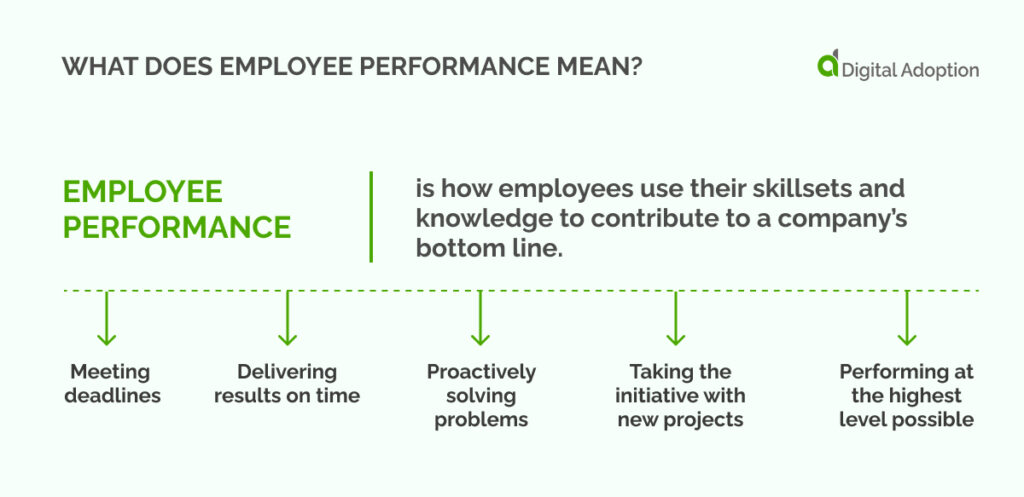
Employee performance is how employees use their skillsets and knowledge to contribute to a company’s bottom line.
This includes meeting deadlines, delivering results on time, proactively solving problems, taking the initiative with new projects, and generally performing at the highest level possible. Ultimately, performance matters because it directly affects a company’s success or failure in achieving its goals.
“Employee performance” also encompasses broader considerations such as understanding customer needs and preferences, using resources efficiently, adhering to standards of conduct and ethics, being continuously trained and up-to-date with industry trends, maintaining healthy work relationships with colleagues, and improving processes whenever necessary. In essence, top performers develop strong work habits while exhibiting professionalism in everything they do.
Why is employee performance important?

Employee performance is essential to any successful business, impacting the bottom line and the wider organizational culture.
Employee performance affects the company’s overall performance by driving productivity, increasing customer satisfaction, and contributing to innovation. A high-performing workforce can also boost morale and create a positive work environment.
As business owners and managers strive to build successful organizations, it’s important that they prioritize employee performance. Doing so ensures that employees have the right skills and ability to complete their tasks efficiently while encouraging them to identify areas for improvement.
Measuring employee performance allows management to make informed decisions about hiring practices, training programs, incentives, and rewards.
Employee performance has far-reaching implications for businesses seeking long-term sustainability and increasing profitability. As evidenced by decades of research, when people feel emotionally fulfilled, they often lead healthier lives filled with joy and productivity.
Workplaces are more productive and successful when the three core psychological needs – autonomy, competence, and relatedness – are met.
Companies have much to gain from nurturing a culture built on high standards of excellence across all departments — starting with management setting an example down through every worker contributing something meaningful towards collective success.
Strong employee performance ultimately helps create a culture of excellence within any organization that values collaboration, recognizes hard work, inspires creativity, and motivates employees to succeed.
How can businesses measure employee performance?

Measuring employee performance is crucial to running a successful business, as it helps ensure that everyone works together and achieves their targets. But how can companies measure employee performance? There are several different methods to do this effectively.
One way to measure employee performance is through goal setting and tracking. By setting goals for each employee and tracking their progress regularly, employers can assess whether they are meeting expectations and, if they still need to, take appropriate action.
Another popular method of measuring employee performance is through feedback and reviews. Regular reviews with managers or supervisors allow employees to provide feedback on their work while also allowing managers to assess overall performance levels.
During these meetings, employers should ask open-ended and closed questions to understand individual performance levels fully.
Employers should also consider using quantitative methods such as collecting data on KPIs (key performance indicators) or other metrics such as sales numbers or customer satisfaction ratings. This approach involves compiling specific data, which allows employers to get an objective view of employee performance levels over time.
Businesses can use various methods to measure employee performance effectively; however, using all three approaches together gives employers the best chance of accurately assessing their team’s overall performance.
7 of the biggest factors that influence employee performance
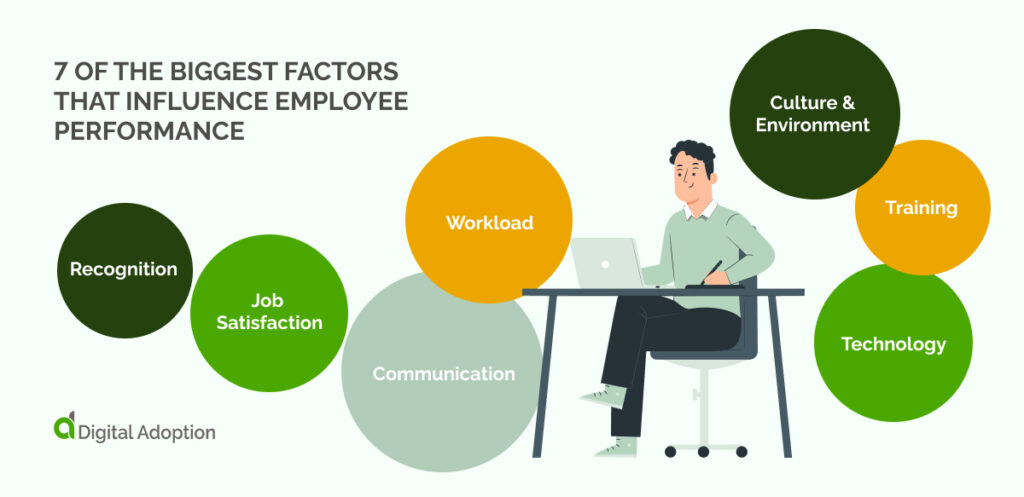
Understanding the factors affecting employee performance is key to creating a successful and productive workplace environment. Whether job satisfaction, recognition, training, communication, or culture, each element can significantly impact how well employees perform in their roles.
Below we explore the seven biggest factors affecting employee performance and share how you can use them to foster an environment that encourages success.
1. Job Satisfaction
Employees who are satisfied with their job are more likely to be productive and successful. Factors such as having a supportive manager, feeling appreciated, and having meaningful work can contribute to higher job satisfaction and improved performance.
2. Recognition
Recognition from management is an important part of employee performance – it helps motivate and encourage employees to do better work. Acknowledging accomplishments and praising can go a long way towards improving employees’ attitudes towards their jobs and inspiring them to perform better.
3. Workload
An overload or underload of tasks significantly impacts an employee’s performance. If employees feel overwhelmed with too much work or burdened when there isn’t enough, it can lead to burnout and decreased productivity over time.
4. Training
Providing opportunities for training and development can give employees the skills they need to excel in their roles. Investing in adequate training will improve their confidence and better equip them to handle the tasks, resulting in better overall performance outcomes for the organization.
5. Technology
In today’s digital age, providing up-to-date technology tools is essential for ensuring employees have everything they need to do their jobs properly and effectively. Properly maintained machines, updated software, reliable Wi-Fi connections, etc., help create an environment that allows employees to work efficiently without being hindered by outdated technology issues or slowdowns due to insufficient hardware/software infrastructure.
6. Communication
Good communication between managers and employees is key for fostering a productive working environment that encourages collaboration among team members while allowing transparency between staff and management regarding expectations, progress updates, feedback, etc. Employees who feel supported by management through regular two-way conversations tend to be more engaged in projects, leading directly to improved performance outcomes.
7. Culture & Environment
The culture within an organization plays a huge role in influencing employee performance. People respond positively when they feel like they belong in an organization with mutual respect among teams and enthusiasm amongst staff around its shared objectives. A positive workplace culture encourages creative thinking, often translating into innovative business solutions.
How can businesses improve employee performance?
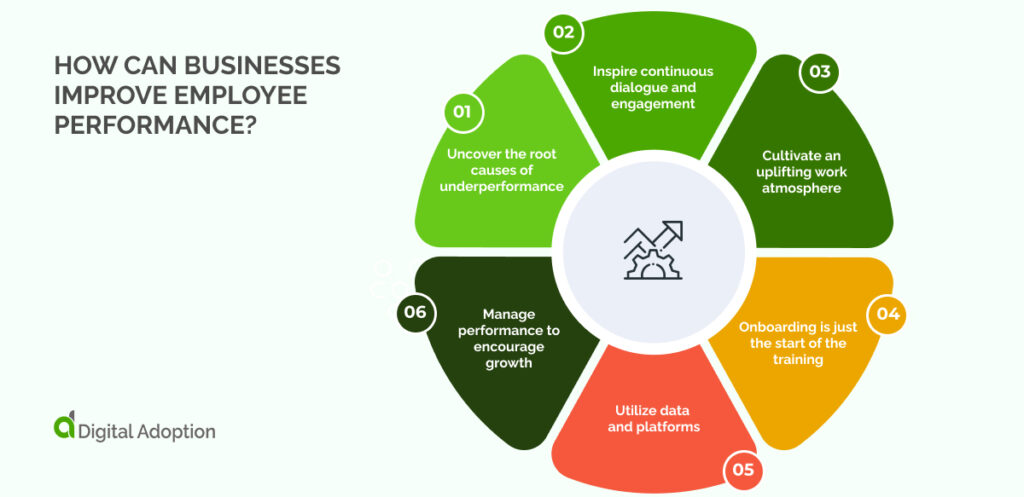
Good performance can differentiate between success and failure, so employees must produce the best work possible. Business leaders need to create an environment and atmosphere conducive to good performance.
Below, we’ve provided an overview of six key strategies businesses can use to ensure they do all they can to improve employee performance.
Uncover the root causes of underperformance.
When it comes to improving employee performance, it’s important for businesses to first look into why performance may be low or inconsistent in the first place.
There are often underlying issues causing poor results that must be addressed before any improvements can be seen. Companies should conduct regular surveys and interviews with employees to better understand what keeps them from reaching their potential. These initiatives help uncover any issues that have been overlooked and allow companies to tailor solutions based on those findings.
Inspire continuous dialogue and engagement.
When attempting to improve employee performance, businesses need to ensure that there is a consistent dialogue taking place between managers and employees regarding both successes and areas needing improvement.
Open communication keeps everyone on the same page regarding expectations and goals; if employees understand what is expected of them, they are more likely to reach those goals. Additionally, engaging with your team helps build trust and allows for feedback from both sides, which can develop better processes within your business.
Cultivate an uplifting work atmosphere.
The type of atmosphere within a workplace greatly impacts how well employees will perform.
Negative environments lead to demotivated workers and lower productivity levels, while positive company cultures tend to produce higher levels of engagement among staff members resulting in better work quality overall.
Therefore, fostering an uplifting work atmosphere through activities such as team building exercises or staff socials helps morale and leads people to feel inspired rather than overwhelmed, resulting in improved motivation levels throughout the workforce.
Onboarding is just the start of the training.
Businesses should consider onboarding as the first step in helping new hires acclimate. Follow-up training is essential for continued learning opportunities designed specifically based on each individual’s strengths and weaknesses.
This ensures that everyone has access to the resources needed to achieve their full potential on the job – enabling them to become even better at what they do. Implementing programs promotes professional development amongst staff members and increases overall satisfaction, which leads to higher retention rates amongst top talent.
Utilize data and platforms.
Data collection tools provide valuable insights into how teams perform by pinpointing trends or patterns related to certain task metrics. This enables leaders to identify where improvements might be necessary and make changes with greater accuracy – allowing teams to remain efficient and effective when implementing strategies.
Additionally, leveraging technology such as platform management systems can track progress directly and set deadlines and organizational objectives. Having these features makes employers easier to stay aligned with strategic initiatives and implement solutions efficiently and quickly while at the same time accommodating changing market conditions too.
Manage performance to encourage growth.
Managing performance is a critical step in improving employee performance. Businesses can better identify where additional training or guidance may be needed by measuring, assessing, and providing feedback on individual performances.
Moreover, recognizing and rewarding employees for their hard work and accomplishments can motivate them to continue producing quality work. This practice helps boost morale and encourages exceptional performance, leading to higher organizational productivity.
Performance Management: The Key To Ensuring Employee Performance
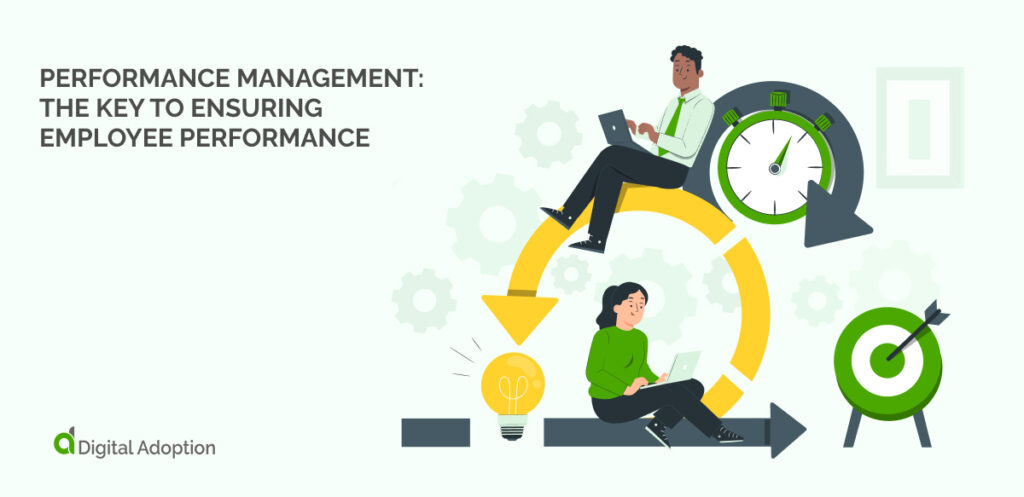
Performance management is essential for improving employee performance, accelerating organizational growth, and ensuring employees perform at the highest level possible. It involves setting goals, providing feedback and development opportunities, and creating an environment where employees can succeed.
Performance management differs from employee performance in that it focuses on helping the organization instead of focusing solely on individual tasks or goals. It helps identify improvement areas and create strategies to reach organizational objectives. On the other hand, employee performance focuses primarily on individual tasks and personal development.
According to a Gartner survey, 81% of HR leaders have modified their performance management system. A few organizations even considered abandoning the numerical or qualitative labels they use for grading employees or contrasting them against each other.
An effective evaluation system should seek to monitor the quality of work and factors like attitude toward learning new skills or working creatively within the framework established by an organization’s mission statement or strategic objectives. The ability to meet expectations in these areas indicates how successfully an individual can contribute to a team environment and ensure that others around them stay engaged too.
Crafting an Effective Performance Evaluation
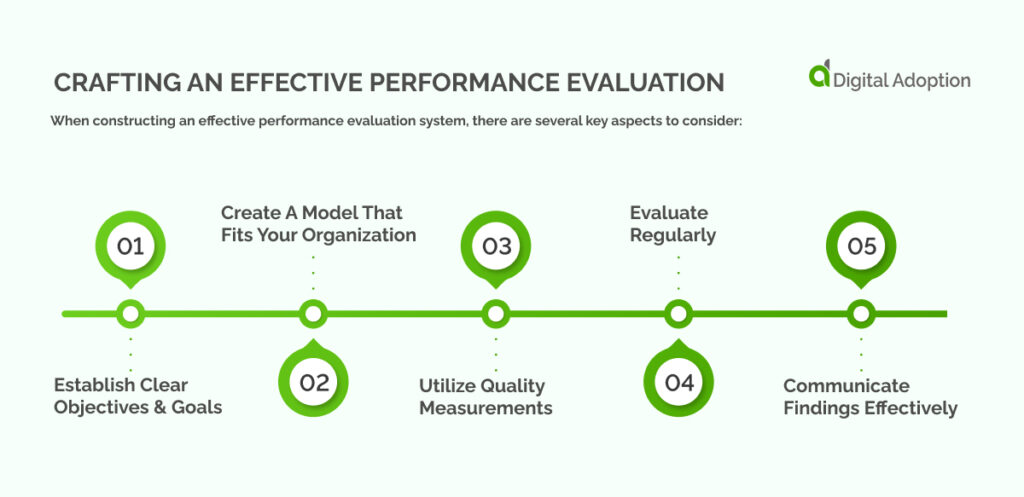
An effective performance evaluation system is a vital tool for any organization. It allows organizations to track progress, recognize achievements, and identify areas where more training or education may be needed.
A strong and comprehensive evaluation system can also provide valuable insight into an organization’s culture. Below we’ll give an overview of performance evaluations, discuss the importance of crafting an effective method, and outline the key steps to constructing a successful evaluation process.
A performance evaluation assesses an employee’s performance, typically on a set of predetermined criteria. It can include qualitative and quantitative measurements, although each measurement’s exact type and weight may differ depending on the organization’s goals.
Performance evaluations are important because they serve as a basis for determining compensation increases or bonuses, providing feedback to improve job performance, identifying areas in which more training or education may be needed, recognizing achievements, and increasing employee job satisfaction, etc.
When constructing an effective performance evaluation system, there are several key aspects to consider:
Establish Clear Objectives & Goals – ensure everyone understands what is expected from them regarding their performance.
Create A Model That Fits Your Organization – tailor your evaluation system to match your organizational culture and needs.
Utilize Quality Measurements – use reliable data sources such as surveys or KPIs that accurately measure employee performance.
Evaluate Regularly – schedule regular reviews to improve employee engagement and productivity.
Communicate Findings Effectively – ensure all relevant parties receive feedback to make positive changes.
Content employees are more productive and successful workers

When we think of productivity in business, our mind often goes to physical labor or the bottom line. It’s easy to forget that content employees are a large part of any company’s success. After all, content employees are engaged with their job, enthusiastic about their work, and dedicated to the company’s mission.
Deloitte’s research on the characteristics of successful teams suggests that today’s corporate groups, much like a cycling peloton, must possess autonomy, flexibility, self-control, and efficiency to reach peak performance. These teams should also be intimately connected to other squads across the organization to grow and achieve their objectives.
Contentment within a workplace has been scientifically shown to increase employee motivation and engagement, which ties into improved performance. That being said, it should come as no surprise that creating an environment where employees feel content with their job can positively impact the business.
Contented employees tend to be more productive than those who are dissatisfied because when someone enjoys what they do, they put more effort into it. Since people naturally tend to be more committed when working on projects and tasks they want, these individuals will likely deliver high-quality results that benefit the organization in multiple ways. In other words, content workers will often be more successful due to increased focus while also making fewer mistakes that could lead to costly delays or errors.
Moreover, contented workers often take the initiative because they want to make positive contributions and improvements in their workplace rather than simply going through the motions out of sheer boredom or dissatisfaction. This type of attitude reinforces a culture of growth and leads organizations forward by inspiring creative concepts and innovative solutions that can expand businesses and create new opportunities for success.
Having content employees who can work towards common goals adds significantly greater value than those who struggle with feeling unsatisfied in the workplace. Investing time into understanding the needs of your team members to provide them with workplace satisfaction will undoubtedly translate into higher levels of effectiveness over time.













